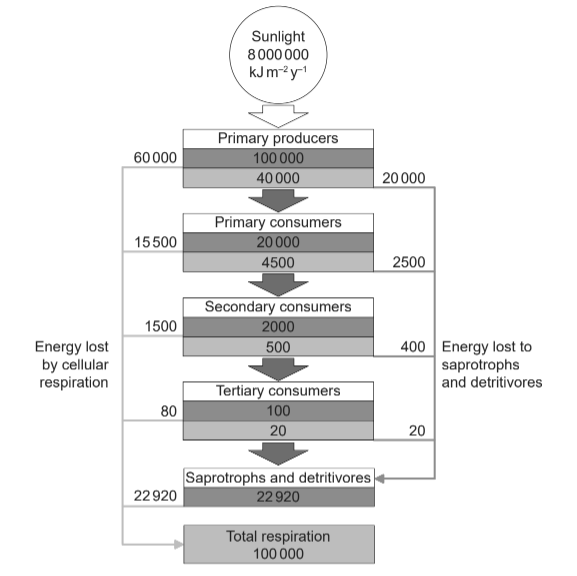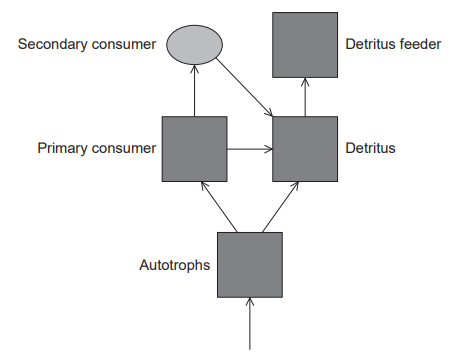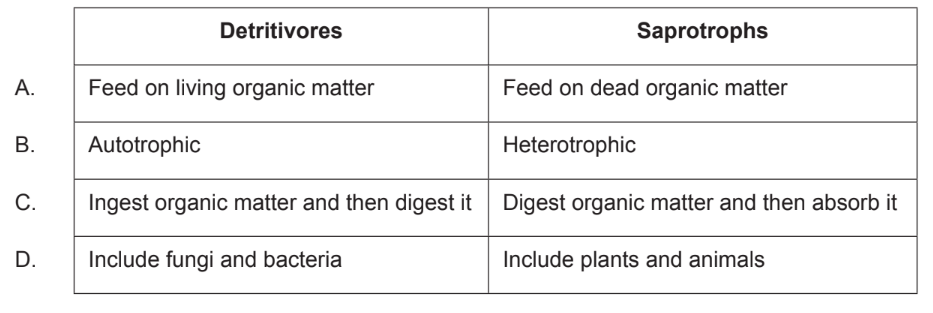IB Biology SL (Standard level)- 2024 – Practice Questions- All Topics
Topic 4.2 Energy flow
Topic 4 Weightage : 10%
All Questions for Topic 4.2 – Energy Source, Energy Flow, Energy Loss, Energy Efficiency, Pyramids of Energy, Ecological Productivity, Food Webs, Ecological Pyramids, Biomagnification
Question
The diagram shows the flow of energy through an ecosystem in kJ m–2 y–1
.
Key: ![]() Gross productivity: the amount of chemical energy that is stored as biomass per unit time
Gross productivity: the amount of chemical energy that is stored as biomass per unit time
![]() Net productivity: the amount of chemical energy that is stored as biomass per unit time after cellular respiration
Net productivity: the amount of chemical energy that is stored as biomass per unit time after cellular respiration
What percentage of the energy passed from primary producers to primary consumers is lost to cellular respiration by tertiary consumers?
A. 0.001 %
B. 0.08 %
C. 0.2 %
D. 0.4 %
▶️Answer/Explanation
Ans: D
Question
The diagram shows the energy flow between five “sinks” in a terrestrial ecosystem.

In a typical terrestrial ecosystem, which trophic level would have the highest biomass?
Autotrophs
Primary consumers
Secondary consumers
Detritus feeders
▶️Answer/Explanation
Ans: A
Autotrophs are organisms that can produce their own food through photosynthesis or chemosynthesis. Because they are able to produce their own food, autotrophs are at the base of the food chain and are the primary producers of organic matter. As a result, they have the highest biomass of any trophic level. This is because they are able to convert energy from the sun or chemicals into organic matter, which can then be used by other organisms in higher trophic levels. As energy is transferred up the food chain, some of it is lost as heat, so there is less energy available to organisms at higher trophic levels. This means that the biomass of organisms at higher trophic levels is typically lower than that of autotrophs.
What is lost between trophic levels in ecosystems and cannot be recycled?
A. Heat
B. Nitrogen
C. Carbon compounds
D. Biomass
▶️Answer/Explanation
Markscheme
A
Heat is lost between trophic levels in ecosystems because of the second law of thermodynamics, which states that energy cannot be recycled and that some energy is always lost as heat as it is transferred from one form to another. When organisms consume other organisms, only a fraction of the energy that was stored in the consumed organism is transferred to the consumer. The rest of the energy is lost as heat or used by the consumed organism for its own metabolic processes. This means that there is less energy available to organisms at higher trophic levels, and that energy is lost as heat as it moves up the food chain. The heat that is lost cannot be recycled because it is not a form of usable energy that can be converted back into organic matter. Instead, it is dissipated into the environment, where it contributes to the overall energy balance of the ecosystem.
What restricts the length of a food chain?
A. Energy losses between the trophic levels
B. A greater biomass at the higher trophic levels
C. The number of species in the food web
D. The consumption of waste by detritivores
▶️Answer/Explanation
Markscheme
A
Energy losses between trophic levels in an ecosystem restrict the length of a food chain because there is less energy available to organisms at higher trophic levels. As energy is transferred up the food chain, some of it is lost as heat, so there is less energy available to organisms at higher trophic levels. This means that there is a limit to the number of trophic levels that can be supported in an ecosystem, since there is not enough energy available to support organisms at higher levels. In general, food chains tend to be relatively short, with only a few trophic levels, because of these energy losses. Longer food chains are possible, but they are less common and tend to be less stable because of the greater energy losses and the greater potential for disruption if any one trophic level is impacted.
What restricts the length of a food chain?
A. Energy losses between the trophic levels
B. A greater biomass at the higher trophic levels
C. The number of species in the food web
D. The consumption of waste by detritivores
▶️Answer/Explanation
Markscheme
A
Energy losses between trophic levels in an ecosystem restrict the length of a food chain because there is less energy available to organisms at higher trophic levels. As energy is transferred up the food chain, some of it is lost as heat, so there is less energy available to organisms at higher trophic levels. This means that there is a limit to the number of trophic levels that can be supported in an ecosystem, since there is not enough energy available to support organisms at higher levels. In general, food chains tend to be relatively short, with only a few trophic levels, because of these energy losses. Longer food chains are possible, but they are less common and tend to be less stable because of the greater energy losses and the greater potential for disruption if any one trophic level is impacted.
Question
What is a difference between detritivores and saprotrophs?

▶️Answer/Explanation
Ans:C
A key difference between detritivores and saprotrophs is that detritivores are organisms that consume dead and decaying organic matter, while saprotrophs are organisms that break down dead and decaying organic matter externally, through the use of enzymes. Detritivores, such as earthworms and woodlice, feed on dead organic matter, breaking it down internally and extracting nutrients from it. In contrast, saprotrophs, such as fungi and bacteria, release enzymes that break down organic matter outside of their bodies, and then absorb the resulting nutrients. Another difference is that detritivores are typically larger organisms, while saprotrophs are typically microscopic. Detritivores play an important role in breaking down organic matter and returning nutrients to the soil, while saprotrophs are important decomposers that help to break down dead organic matter in a wide range of environments.
Question
A self-sustaining system is set up in a sterile, sealed, transparent glass bottle with damp, sterilized soil and a small garden plant. If the system remains sterile, what could be the reason that the plant fails to grow and dies?
A. Lack of soil nutrients
B. Lack of oxygen
C. Lack of space
D. Lack of water
▶️Answer/Explanation
Ans:A
The lack of soil nutrients can impact the growth of a plant in a self-sustaining system set up in a sterile, sealed, transparent glass bottle with damp, sterilized soil because plants require a variety of nutrients to grow and thrive. Without these nutrients, the plant may be stunted or may not grow at all. In a self-sustaining system, the nutrients that are present in the soil are the only source of nutrition for the plant, so if these nutrients are not present in sufficient quantities, the plant will suffer. In addition, the sealed nature of the system means that there is no way for new nutrients to enter the system, so the plant is entirely dependent on the nutrients that are already present in the soil. Over time, these nutrients may be depleted, which can further impact the growth of the plant. To prevent this, it is important to carefully monitor the nutrient levels in the soil and to add additional nutrients as needed to ensure that the plant has the resources it needs to grow.